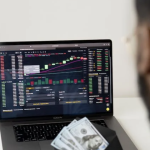In the ever-shifting realm of forex trading, one concept stands as a testament to the market’s capricious nature – volatility. This tempestuous force fuels the heart of price movements, dictating the ebb and flow of trading landscapes. In this illuminating guide, we delve into the intricacies of forex volatility, unraveling its significance, impact, and invaluable tips to harness its power for prosperous trading.
Understanding Forex Volatility: A Prerequisite
At its core, volatility reflects the oscillations in asset prices within a defined timeframe. A currency pair’s volatility is a tangible measure of the price disparity between its opening and closing points over a specific period. For instance, a currency pair oscillating between a 5-10 pip range exudes less volatility compared to its counterpart flitting between 50-100 pips.
A keen observer discerns the varying degrees of volatility inherent to currencies and currency pairs. The concept of “safe havens,” encompassing currencies like the Japanese Yen, Swiss Franc, and the US Dollar (to a certain extent), underscores this diversity. In contrast, the realm of emerging markets and exotic currency pairs, including the Turkish Lira, Mexican Peso, Indian Rupee, and Thai Baht, pulsates with heightened volatility.
This dynamic spectrum of volatility equips traders with a panoramic canvas to align their trading styles, strategies, and preferences with currencies that resonate with their individual techniques. While some traders thrive amidst the tempest of volatile markets, others opt for the tranquility of less risk-laden waters.
Intricately Woven: The Nexus Between Market Liquidity and Volatility
The interplay between market liquidity and volatility weaves a complex tapestry that shapes trading landscapes. To comprehend this synergy, a foundational understanding of liquidity is imperative.
Liquidity, akin to a river’s flow, embodies the ease with which assets are bought or sold. Consider the scenario of purchasing 100 ounces of Gold – a seamless transaction hinges upon the presence of a willing seller. Highly liquid instruments facilitate such exchanges seamlessly. For instance, executing a EUR/USD trade valued at 10 million during London’s bustling market hours is a feat accomplished without market upheaval.

However, timing is an instrumental factor, for liquidity may ebb during specific market sessions. Executing the same EUR/USD trade between the closure of US trading and Tokyo’s impending dawn may unveil a different narrative. In such moments, liquidity may wane, potentially leading to a less favorable execution.
Intriguingly, a symbiotic relationship emerges between market liquidity and volatility. The more liquid an instrument, the lower its volatility. Substantial efforts are required to steer highly liquid instruments in a singular direction. Conversely, emerging market currencies, exemplified by the Mexican Peso and South African Rand, display heightened volatility, reflecting their susceptibility to market shifts.
Unmasking the Essence: The Significance of Volatility in Forex
“The fact is uncertainty, volatility, fluctuations…are all intrinsic parts of trading the markets.” – Warren Buffett
In the captivating tango of trading, volatility is an immutable partner. A dormant market devoid of volatility becomes a barren landscape, bereft of price motions and trading activities. The essence of successful trading, however, lies in understanding that a requisite level of volatility is vital for market vitality.
Nonetheless, the equilibrium teeters when volatility surges to excessive heights. The challenge for traders lies in discerning the tipping point. As a forex trader, cultivating awareness of the volatility landscape – identifying currencies prone to greater volatility and gauging rising volatility levels – is paramount.
Unveiling the Architects: Catalysts of Currency Pair Volatility

Amidst the fabric of interconnected global markets, volatility emerges as a prominent preoccupation for traders. A symphony of factors triggers the volatility crescendo that shapes the forex landscape.
- Geopolitical Tumult: Wars, uprisings, and civil unrest unfurl a tapestry of volatility. Prolonged uncertainty casts a shadow over market sentiment, distorting the market’s equilibrium.
- Trade Wars: Global economic frictions, like trade wars, exert seismic impacts on market dynamics. The oscillations ripple across currencies embroiled in these trade skirmishes.
- Monetary Musings: Central banks, the maestros of monetary policies, orchestrate market flows through interest rate modulation. Traders’ vigilant eyes fixate on decisions from institutions like the US Federal Reserve, European Central Bank, and others, shaping market volatility.
- Sentiment Sways: Markets are driven by individuals’ actions. Traders and investors galvanize market movements. Market sentiment, whether optimistic or pessimistic, becomes a pivot point for volatility.
Navigating the Volatile Waters: Spotlight on Currency Pairs
Within the forex cosmos, certain currency pairs emerge as the protagonists of volatility, scripting narratives of flux and fervor. Explore a trio of such pairs, each with its unique volatility signature:
- AUD/JPY: The Risk Barometer: The AUD/JPY duo resonates as a risk gauge. The Australian Dollar thrives in “risk-on” scenarios, surging with optimism. In contrast, the Japanese Yen, a bastion of safety, ascends during risk-averse periods. This yin-yang dynamic orchestrates AUD/JPY’s volatility, manifesting peaks of optimism and troughs of caution.
- GBP/CAD: The Tempestuous Cross-Rate: The British Pound cross-rates, epitomized by GBP/CAD, reign supreme in volatility. The Canadian Dollar, entwined with oil prices, dances to the rhythm of the energy market. “Risk-off” scenarios coupled with plummeting oil prices may jar the Canadian Dollar, while surging commodities buoy its fortunes.
- USD/TRY: Unveiling Political Ripples: The Turkish Lira, often shrouded in geopolitical intrigue, scripts tales of dramatic price fluctuations. Political machinations, intertwined with central bank uncertainty, contribute to USD/TRY’s capricious character.
Unleash the Power: Harnessing Volatility for Forex Triumph
Harnessing volatility, rather than recoiling from it, amplifies your trading prowess. Warren Buffett’s counsel of befriending volatility echoes with wisdom, inviting traders to leverage it for their advantage. Several strategies invite you to seize the reins:
- Embrace Stop Loss Orders: Safeguard your trades with stop loss orders, fortifying against market volatility’s unforeseen surges.
- Navigate the Economic Calendar: The economic calendar unveils impending market-shifting events. Acquainting yourself with these milestones grants a measure of anticipation amidst volatile tides.
- Moderate Leverage: Leverage, akin to a double-edged sword, amplifies gains and magnifies losses. Restrain its use, embedding risk management strategies within your trading fabric.
Deciphering Volatility: A Technical Toolkit
The tapestry of volatility invites exploration through technical indicators. Among them, two stalwarts resonate:




